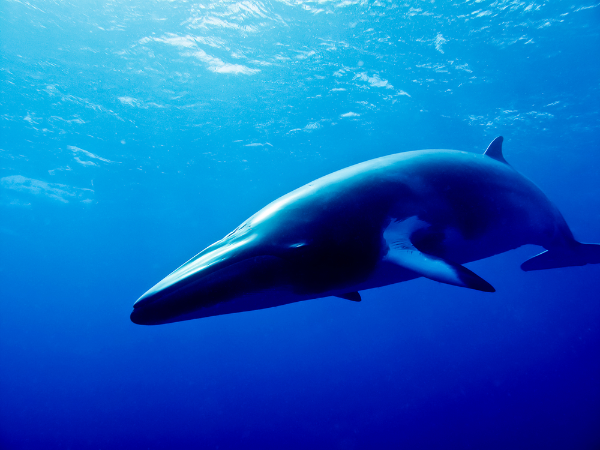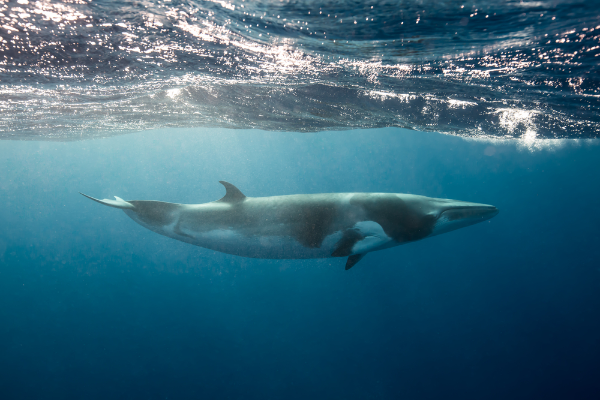The minke whale is a small to medium-sized baleen whale that is found in all the world’s major oceans. They are one of the most abundant large whales and are also one of the least studied. These fascinating creatures have many unique characteristics that make them worthy of further study. In this blog post, we will discuss some of the interesting facts about minke whales. We will also explore why they are such an important part of our ocean ecosystems. Stay tuned for more information about these amazing animals!

Minke Whale Description
Minke whales are the second smallest member of the baleen whale family. They are easily identified by their small size, white bands on their flippers, and distinctive curved dorsal fins. Minke whales are found in all the world’s oceans, and they are known to migrate long distances. In the summer months, they can be found in polar waters, where they feed on krill and small fish. In the winter, they move to warmer waters near the equator. Although they are not considered endangered, Minke whales are still hunted by some countries. Their meat is considered a delicacy in Japan, and Minke whale oil is used in a variety of products. As a result, these gentle giants face an uncertain future.
Minke Whale Habitat
Minke whales are found in all the world’s oceans, from the polar regions to the equator. They prefer waters that are relatively deep (at least 1,000 meters/3,280 feet), with a temperature of 10-12 degrees Celsius/50-54 degrees Fahrenheit. Minke whales are often seen near continental shelves and around areas of upwelling, where cold, nutrient-rich water rises to the surface. These conditions provide an abundance of small fish and krill, which form the basis of the Minke whale’s diet. The specific habitat requirements of Minke whales can vary depending on the population. For example, Antarctic Minke whales spend the winter in open waters away from the ice edge, while migrating to coastal areas during the austral summer to feed on krill and small fish. Minke whales are generally found solitary or in pairs, although they may form loose groups of up to 10 individuals while feeding. Their flexible habitat use and lack of specialization make Minke whales one of the least threatened cetacean species. However, some populations (such as those in the North Atlantic) are facing increasing pressure from human activities, such as fisheries and ship traffic.
Minke Whale Diet
Minke Whale diet consists mostly of krill, small squid and fish. Minke Whales are often seen feeding at the surface of the water, lunging forward with their mouths open to gulp in large volumes of prey-laden water. Minke Whales then push the water out through their baleen plates, which trap the soft-bodied prey like krill, shrimp and small fish. Minke Whales have also been known to eat large squid. The stomachs of Minke Whales captured in Japanese waters contained up to 75% squid by volume. Minke Whales have been known to eat large squid. The stomachs of Minke Whales captured in Japanese waters contained up to 75% squid by volume.
Minke Whale Size
Minke whales are the smallest of the baleen whales, with adults typically measuring between 6 and 9 meters in length. They weigh up to 10 tons. They are easily distinguished from other whale species by their small size, narrow body and sharp pointed snout. Minke whales are found in all the world’s oceans, and are particularly common in the Southern Hemisphere. They are known to form close associations with other whale species, and have often been seen swimming alongside sperm whales, fin whales and blue whales. Minke whales are relatively timid creatures, and are seldom seen approaching boats or humans. However, they are curious animals, and have been known to approach divers who are exploring the ocean depths. Minke whales are an important part of the marine ecosystem, and their populations play a crucial role in maintaining the health of the world’s oceans.

Minke Whale Lifespan
Minke whales are a type of baleen whale that can be found in all the world’s oceans. They are among the smallest of the baleen whales, and have an average lifespan of about 50 years. Minke whales are generally solitary creatures, but can sometimes be found in small groups. They are known to be curious and sometimes approach boats out of curiosity. Minke whales primarily eat krill and small fish, and can consume up to 900 pounds of food per day. Despite their small size, minke whales are powerful swimmers and can reach speeds of up to 35 miles per hour. These majestic creatures are an important part of the ocean ecosystem, and their long lifespan ensures that they will be around for generations to come.
Minke Whale Behavior
Minke whales are a type of baleen whale, which means that they filter their food from the water using baleen plates. Despite their large size, they are very graceful swimmers. Minke whales are often seen alone or in pairs, but they are also found in small groups. They eat krill, squid, and small fish. Minke whales have a life span of 50 years or more. They are not considered to be endangered at this time.
Minke Whale Speed
Minke whales are one of the faster swimming whale species, able to reach speeds of up to 35 miles per hour when chasing prey. These nimble predators are often seen swimming alongside boats and are known for their friendly nature. Minke whales are relatively small compared to other whale species, measuring in at an average of 30 feet long. However, they are still a powerful force in the ocean, with a large body mass that can weigh up to 10 tons. Minke whales have a dark grey or black back, with a white underside. Their diet consists mainly of small fish, squid, and krill. Minke whales are found in all oceans around the world, and their populations are currently healthy and expanding. Thanks to their speed and agility, Minke whales are able to outswim many of their predators, such as killer whales and sharks. As a result, Minke whales have little to fear from humans and can often be seen approaching swimmers and boats in open waters.
Minke Whale Hunting
Minke whale hunting is the practice of killing minke whales for their meat, oil, and blubber. Minke whale hunting has a long history, with many different cultures hunting the animals for different purposes. In some cultures, minke whale meat is considered a delicacy, while in others it is used as a source of food and fuel. Minke whale oil is also used in a variety of products, including cosmetics and lubricants. Minke whale hunting is currently regulated by the International Whaling Commission, which has placed a moratorium on commercial whaling. However, some indigenous communities are still allowed to hunt minke whales for subsistence purposes. Minke whale hunting has come under criticism from animal rights activists, who argue that it is cruel and unnecessary. However, many indigenous people see hunting as an important part of their culture and way of life.
Conclusion
The minke whale is a small baleen whale that can be found in all the world’s oceans. They are one of the most abundant whales and are known for their playful behavior. While they were once hunted extensively, they are now considered a conservation success story.
Frequently Asked Question

